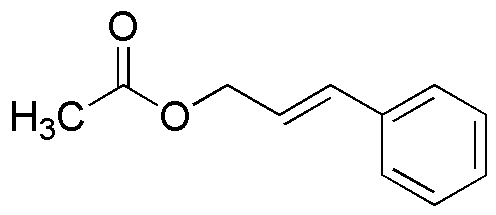Cinnamyl acetate is widely utilized in research focused on:
- Fragrance Industry: This compound is a key ingredient in perfumes and cosmetics, providing a sweet, warm scent reminiscent of cinnamon. Its pleasant aroma makes it popular in personal care products.
- Flavoring Agent: Cinnamyl acetate is used in the food industry as a flavoring agent, imparting a sweet and spicy flavor to various food products, including candies and baked goods.
- Pharmaceutical Applications: In medicinal chemistry, it serves as a building block for synthesizing various pharmaceutical compounds, enhancing the efficacy of certain drugs.
- Natural Insect Repellent: Research has shown that this compound can act as a natural insect repellent, making it a valuable ingredient in eco-friendly pest control products.
- Research in Organic Synthesis: Cinnamyl acetate is often used in organic synthesis for creating complex molecules, helping researchers develop new materials and compounds with unique properties.
General Information
Properties
Safety and Regulations
Applications
Cinnamyl acetate is widely utilized in research focused on:
- Fragrance Industry: This compound is a key ingredient in perfumes and cosmetics, providing a sweet, warm scent reminiscent of cinnamon. Its pleasant aroma makes it popular in personal care products.
- Flavoring Agent: Cinnamyl acetate is used in the food industry as a flavoring agent, imparting a sweet and spicy flavor to various food products, including candies and baked goods.
- Pharmaceutical Applications: In medicinal chemistry, it serves as a building block for synthesizing various pharmaceutical compounds, enhancing the efficacy of certain drugs.
- Natural Insect Repellent: Research has shown that this compound can act as a natural insect repellent, making it a valuable ingredient in eco-friendly pest control products.
- Research in Organic Synthesis: Cinnamyl acetate is often used in organic synthesis for creating complex molecules, helping researchers develop new materials and compounds with unique properties.
Documents
Safety Data Sheets (SDS)
The SDS provides comprehensive safety information on handling, storage, and disposal of the product.
Product Specification (PS)
The PS provides a comprehensive breakdown of the product’s properties, including chemical composition, physical state, purity, and storage requirements. It also details acceptable quality ranges and the product's intended applications.
Certificates of Analysis (COA)
Search for Certificates of Analysis (COA) by entering the products Lot Number. Lot and Batch Numbers can be found on a product’s label following the words ‘Lot’ or ‘Batch’.
*Catalog Number
*Lot Number
Certificates Of Origin (COO)
This COO confirms the country where the product was manufactured, and also details the materials and components used in it and whether it is derived from natural, synthetic, or other specific sources. This certificate may be required for customs, trade, and regulatory compliance.
*Catalog Number
*Lot Number
Safety Data Sheets (SDS)
The SDS provides comprehensive safety information on handling, storage, and disposal of the product.
DownloadProduct Specification (PS)
The PS provides a comprehensive breakdown of the product’s properties, including chemical composition, physical state, purity, and storage requirements. It also details acceptable quality ranges and the product's intended applications.
DownloadCertificates of Analysis (COA)
Search for Certificates of Analysis (COA) by entering the products Lot Number. Lot and Batch Numbers can be found on a product’s label following the words ‘Lot’ or ‘Batch’.
*Catalog Number
*Lot Number
Certificates Of Origin (COO)
This COO confirms the country where the product was manufactured, and also details the materials and components used in it and whether it is derived from natural, synthetic, or other specific sources. This certificate may be required for customs, trade, and regulatory compliance.

